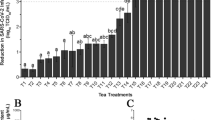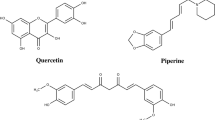Abstract
Twenty natural compounds isolated from traditional Chinese medicines were examined for their antiviral activities against PCV2 in vitro. Antiviral activity was analyzed by the assays of blocking of virus entry, inhibition of virus replication and inactivation of virus particles in the virus suspension. 50% cytotoxic concentration (CC50) and 50% effective concentration (EC50) for each compound were determined by using the MTT method and immunofluorescence assay (IFA), respectively. The results obtained from the inhibition of virus replication and inactivation of virus particles showed that the maximum inhibition rates for matrine and scutellarin were 57 and 72.69% and their SI were 29.87 and 18.66, respectively. However, the results from the assays of inhibition of virus entry and inhibition of virus replication demonstrated that both aesculetin and arecoline hydrochloride stimulated PCV2 replication, with the maximum stimulation rate of 387.3 and 219.4%. In summary, both matrine and scutellarin had antiviral activity against PCV2, while aesculetin and arecoline hydrochloride promoted PCV2 infection replication in vitro.
Similar content being viewed by others
References
Tischer, I., H. Gelderblom, W. Vettermann, and M. Koch (1982) A very small porcine virus with circular single-stranded DNA. Nature 295: 64–66.
Allan, G. M. and J. A. Ellis (2000) Porcine circoviruses: A review. J. Vet. Diagn. Invest. 12: 3–14.
Tischer, I., R. Rasch, and G. Tochtermann (1974) Characterization of papovavirus-and picornavirus-like particles in permanent pig kidney cell lines. Zentralbl. Bakteriol. Orig. A. 226: 153–167.
Jacobsen, B., L. Krueger, F. Seeliger, M. Bruegmann, J. Segalés, and W. Baumgaertner (2009) Retrospective study on the occurrence of porcine circovirus 2 infection and associated entities in Northern Germany. Vet. Microbiol. 138: 27–33.
Grau-Roma, L., L. Fraile, and J. Segalés (2011) Recent advances in the epidemiology, diagnosis and control of diseases caused by porcine circovirus type 2. Vet. J. 187: 23–32.
Segalés, J., T. Kekarainen, and M. Cortey (2013) The natural history of porcine circovirus type 2: From an inoffensive virus to a devastating swine disease? Vet. Microbiol. 165: 13–20.
Li, T. and T. Peng (2013) Traditional Chinese herbal medicine as a source of molecules with antiviral activity. Antiviral Res. 97: 1–9.
Perera, C. and T. Efferth (2012) Antiviral medicinal herbs and phytochemicals. J. Pharmacogn. 3: 45–48.
Karuppannan, A. K., K. X. Wu, J. Qiang, J. J. H. Chu, and J. Kwang (2012) Natural compounds inhibiting the replication of Porcine reproductive and respiratory syndrome virus. Antiviral Res. 94: 188–194.
Sun, Y., M. Song, L. Niu, X. Y. Bai, N. Sun, X. Zhao, J. B. Jiang, J. P. He, and H. Q. Li (2013) Antiviral effects of the constituents derived from Chinese herb medicines on infectious bursal disease virus. Pharm. Biol. 51: 1137–1143.
Wang, Z., N. Sun, C. H. Wu, J. B. Jiang, Y. S. Bai, and H. Q. Li (2013) In vitro antiviral activity and underlying molecular mechanisms of dipotassium glycyrrhetate against porcine reproductive and respiratory syndrome virus. Antivir.Ther. 18: 997–1004.
Sun, Y.G., L. Niu, M. Q. Song, X. Zhao, N. Sun, J. P. He, C. H. Wu, J. B. Jiang, Y. S. Bai, J. H. Guo, and H. Q. Li (2014) Screening compounds of Chinese medicinal herbs anti-MDV. Pharm. Biol. 52: 841–847.
Zhang, J. Q., Y. L. Gu, C. H. Wu, H. L. Ma, J. P. He, Y. S. Bai, and H. Q. Li (2013) Effects of sodium tanshinone IIA sulfonate against Marek's disease virus in experimentally infected chickens. Int. J. Biol. Macromol. 58: 258–262.
Sun, N., E. Li, Z. W. Wang, J. X. Zhao, S. Y. Wang, J. P. He, Y. S. Bai, and H. Q. Li (2014) Sodium tanshinone IIA sulfonate inhibits porcine reproductive and respiratory syndrome virus via suppressing N gene expression and blocking virus induced apoptosis. Antivir. Ther. 19: 89–95.
Cheng, J., N. Sun, X. Zhao, M. Q. Song, J. B. Jiang, Y. S. Bai, and H. Q. Li (2013) In vitro screening for compounds derived from traditional chinese medicines with antiviral activities against porcine reproductive and respiratory syndrome virus. J. Microbiol. Biotech. 23: 1076–1083.
Sun, N., Z. W. Wang, C. H. Wu, E. Li, J. P. He, S. Y. Wang, Y. S. Bai, and H. Q. Li (2014) Antiviral activity and underlying molecular mechanisms of Matrine against porcine reproductive and respiratory syndrome virus in vitro. Res. Vet. Sci. 96: 323–327.
Reed, L. J. and H. Muench (1938) A simple method of estimating fifty per cent endpoints. Am. J. Epidemiol. 27: 493–497.
Mosmann, T. (1983) Rapid colorimetric assay for cellular growth and survival: Application to proliferation and cytotoxicity assays. J. Immunol. Methods 65: 55–63.
Glatthaar-Saalmüller, B., U. Rauchhaus, S. Rode, J. Haunschild, and A. Saalmüller (2011) Antiviral activity in vitro of two preparations of the herbal medicinal product Sinupret® against viruses causing respiratory infections. Phytomed. 19: 1–7.
Fan, Y., J. Liu, D. Wang, Y. Hu, S. Yang, J. Wang, L. Guo, X. Zhao, H. Wang, and Y. Jiang (2011) Epimedium polysaccharide and propolis flavone can synergistically inhibit the cellular infectivity of NDV and improve the curative effect of ND in chicken. Int. J. Biol. Macromol. 48: 439–444.
Sun, N., X. Zhao, X. Y. Bai, L. Niu, M. Q. Song, Y. G. Sun, J. B. Jiang, and H. Q. Li (2012) Anti-PRRSV effect and mechanism of sodium tanshinone IIA sulfonate in vitro. J. Asian Nat. Prod. Res. 14: 721–728.
Chávez, J.H., P. C. Leal, R. A. Yunes, R. J. Nunes, C. R. Barardi, A. R. Pinto, C. M. Simões, and C. R. Zanetti (2006) Evaluation of antiviral activity of phenolic compounds and derivatives against rabies virus. Vet. Microbiol. 116: 53–59.
Tischer, I., D. Peters, R. Rasch, and S. Pociuli (1987) Replication of porcine circovirus: Induction by glucosamine and cell cycle dependence. Arch. Virol. 96: 39–57.
Liu, M., X. Y. Liu, and J. F. Cheng (2003) Advance in the pharmacological research on matrine. Zhongguo Zhong Yao Za Zhi 28: 801–804. (in Chinese, with an English abstract).
Ye, G., H. Y. Zhu, Z. X. Li, C. H. Ma, M. S. Fan, Z. L. Sun, and C. G. Huang (2007) LC-MS characterization of efficacy substances in serum of experimental animals treated with Sophora flavescens extracts. Biomed. Chromatogr. 21: 655–660.
Cheung, A. K. (2003) Transcriptional analysis of porcine circovirus type 2. Virol. 305: 168–180.
Wei, L., Z. Zhu, J. Wang, and J. Liu (2009) JNK and p38 mitogen-activated protein kinase pathways contribute to porcine circovirus type 2 infection. J. Virol. 83: 6039–6047.
Zhang, G. H., Q. Wang, J. J. Chen, X. M. Zhang, S. C. Tam, and Y. T. Zheng (2005) The anti-HIV-1 effect of scutellarin. Biochem. Bioph. Res. Co. 334: 812–816.
Author information
Authors and Affiliations
Corresponding author
Additional information
These authors contributed equally to this work.
Rights and permissions
About this article
Cite this article
Sun, N., Yu, T., Zhao, JX. et al. Antiviral activities of natural compounds derived from traditional chinese medicines against porcine circovirus type 2 (PCV2). Biotechnol Bioproc E 20, 180–187 (2015). https://doi.org/10.1007/s12257-014-0520-8
Received:
Revised:
Accepted:
Published:
Issue Date:
DOI: https://doi.org/10.1007/s12257-014-0520-8




